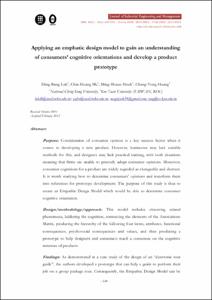Applying an empathic design model to gain an understanding of consumers’ cognitive orientations and develop a product prototype

Visualitza/Obre
Estadístiques de LA Referencia / Recolecta
Inclou dades d'ús des de 2022
Cita com:
hdl:2099/12688
Tipus de documentArticle
Data publicació2012-04
EditorSchool of Industrial and Aeronautic Engineering of Terrassa (ETSEIAT). Universitat Politècnica de Catalunya (UPC)
Condicions d'accésAccés obert
Llevat que s'hi indiqui el contrari, els
continguts d'aquesta obra estan subjectes a la llicència de Creative Commons
:
Reconeixement-NoComercial 3.0 Espanya
Abstract
Purpose: Consideration of consumer opinion is a key success factor when it comes to developing a new product. However, businesses may lack suitable methods for this, and designers may lack practical training, with both situations meaning that firms are unable to precisely adopt consumer opinions. Moreover, consumer cognitions for a product are widely regarded as changeable and abstract. It is worth studying how to determine consumers’ opinions and transform them into references for prototype development. The purpose of this study is thus to create an Empathic Design Model which would be able to determine consumer cognitive orientation.
Design/methodology/approach: This model includes observing related phenomena, laddering the cognition, connecting the elements of the Associations Matrix, producing the hierarchy of the following four items, attributes, functional consequences, psychosocial consequences and values, and then producing a prototype to help designers and consumers reach a consensus on the cognitive structure of products.
Findings: As demonstrated in a case study of the design of an “electronic tour guide”, the authors developed a prototype that can help a guide to perform their job on a group package tour. Consequently, the Empathic Design Model can be operated and put into practice. By Mind Mapping, the prototype can be then imitated and reinvented by designers as needed.
Originality/value: This model focuses on the early phase of the design process, providing the designing industry with a technique to forecast consumers’ potential needs and develop a prototype effectively
CitacióLuh, Ding-Bang [et al.]. Applying an empathic design model to gain an understanding of consumers’ cognitive orientations and develop a product prototype. "Journal of Industrial Engineering and Management", Abril 2012, vol. 5, núm. 1, p. 229-258.
Dipòsit legalB-28744-2008
ISSN2013-0953
| Fitxers | Descripció | Mida | Format | Visualitza |
|---|---|---|---|---|
| luh.pdf | 1,248Mb | Visualitza/Obre |


